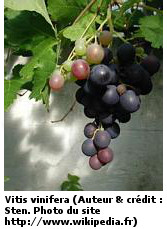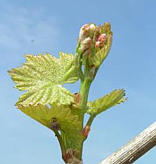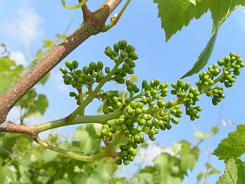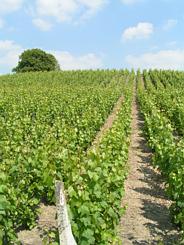
Only one genus,Vitis, produces edible berries. It contains about 60 dioecious species that are distributed almost equally between America and Asia and represent a considerable resource for resistance to pathogens (Mullins & al, 1992). Vitis vinifera L. is the only species originating from Eurasia and it has been spread throughout the world by human cultivation. TheVitaceae family is a basal family of the rosids (Jansen
& al, 2006).
 The number of chromosome per haploid genome across the Vitacea family varies from 11 to 20. Cytological observations of F1 hybrids between Vitis vinifera (2n=38) and Muscadinia rotundifolia (2n=40), suggested an allopolyploid origin of the Vitis genome (Mullins & al, 1992).
The number of chromosome per haploid genome across the Vitacea family varies from 11 to 20. Cytological observations of F1 hybrids between Vitis vinifera (2n=38) and Muscadinia rotundifolia (2n=40), suggested an allopolyploid origin of the Vitis genome (Mullins & al, 1992).
Perennial liana like Vitis vinifera have many developmental aspects different from Arabidopsis, poplar,Medicago and tomato, which include a unique shoot architecture with petiolated leaves opposite to either inflorescences or tendrils. Inflorescences have a pyramidal branched structure with an asynchronous development of flowers. The five petals of the flowers are jointed into a cap structure which falls at anthesis, liberating the stamens and the pistil. Particularly adapted to avian dissemination, the berry pericarp undergoes multifaceted metabolic changes common to most fleshy fruits species as they shift from a repulsive to an attractive status. The transition between these two status is abrupt and the trigger remains unknown (Mullins & al, 1992). Unlike in tomato, berry ripening occurs without an increase in respiration, or a significant emission of ethylene.
Why sequence the genome of the grape?
The grape constitutes a major species for European agriculture. In order to increase its economic competitivity and to adapt its cultivation to new production objectives which result from climate change, the emergence of new diseases, environmental protection imperatives and consumer behavior, it is necessary to increase our knowledge of its physiology and pathology, and to develop genetic tools and resources for its amelioration.

Credits : Virginie Curtil
Although its biology precludes its usefulness as a model organism (it is a perennial plant with high heterozygosity and a long reproductive cycle), it has rapidly become evident that it is not only possible, but even necessary to develop the genomic tools to accelerate the acquisition of knowledge about important agronomic characteristics such as resistance to diseases, tolerance to abiotic stress, maturation and quality of the fruit. One of the objectives of the consortium was the establishment of a sequencing project for the genome of the grape.
The recent availability of the sequence of model species genomes like Arabidopis and rice (and soon coming of Medicago, poplar and tomato) together with the fact that the grape genome is small (475 Mb), leaded the scientific community working on grapevine to create a consortium, the International Grape Genome Program (IGGP), aiming at the coordination of the development of genomic resources in grapevine .

Credits : Virginie Curtil
A knowledge of the genome of the grape will considerably encourage the transfer of results from model organisms involving the molecular mechanisms implicated in important agronomic charactistics which are already known, to the grape. Information about the sequences of the genes of the grape is necessary to better understand its biological features: perennial nature, fleshy fruit, maturation signals which are different from those of the tomato, tendency to be dioecious, etc. It will lead to functional genomics approaches which have shown their value and efficacity for the study of complex characteristics in other species. Special attention will thus be given to regions which carry “clusters” of sequences which are homologous to genes for resistance or defense against diseases; an understanding of these will facilitate the exploration of genetic resources and access to the alleles implicated in these mechanisms. This information should also make it possible to respond to a great need for markers of the physiological state of the plant in the vinyard in order to develop tools for a more precise viticulture which is more sustainable and of high quality (adaptation to hydric stress, the relationship between technological quality and the state of maturation of the fruit, etc.).
Creation of a Franco-Italian project
In autumn 2004, following pressure from the international community on the positioning of France in the context of the sequencing of the grape genome, the Scientific Council of Genoscope emitted a favorable recommendation for the sequencing of this genome using a whole genome shotgun strategy with three-fold coverage. In parallel, the Institut National de la Recherche Agronomique (INRA) applied to the Agence Nationale de la Recherche (ANR) for complementary sequencing at the level of 6 genome equivalents. ANR gave Genoscope a positive response to this application in May 2005, and in July 2005, France and Italy (University of Padua, University of Milan and the University of Udine) signed a collaborative agreement for the sequencing of the genome of the grape. The Italian contribution will involve the sequencing of at least 3 genome equivalents. The Franco-Italian program for sequencing the grape genome will lead to a minimum coverage of 12 genome equivalents. Furthermore, the program for the grape genome is co-ordinated with the sequencing of a strain of yeast (EC-1118) which is used in vinification and with a strain of the pathogen agent Botrytis cinerea.
Strategy

Credits : Virginie Curtil
The sequencing of the genome of Vitis vinifera is being performed on the quasi-homozygous genotype PN40024 which was created by INRA in Colmar (Bronner and Oliveira, 1990). The size of its genome is estimated at 475 Mb (Lodhi and Reisch, 1995). The chosen strategy is whole genome shotgun with a minimum coverage of 12 genome equivalents. Several plasmid libraries with different insert sizes (3 and 10 kb) have been constructed and are currently being sequenced. A HindIII BAC library of 70,656 clones has been constructed and the end-sequences obtained. In addition, a fosmid library (35 kb) is being constructed in order to obtain the long-distance clone links necessary for assembly. The ensemble of the sequences obtained will be assembled using the ARACHNE assembler (Broad Institute) and an automatic annotation will be performed.
In parallel, a physical and genetic map comprising more than 1,500 markers will be constructed. It will permit anchoring and orientation of the super-contigs on the 19 chromosomes.
Resources:
Sequencing:
Annotations:
Reference :
Jaillon O., Aury J-M, Noel B., Policriti A., Clepet C.,Casagrande A., Choisne N., Aubourg S., Vitulo N., Jubin C., Vezzi A., Legeai F., Hugueney P., Dasilva C., Horner D., Mica E., Jublot D., Poulain J., Bruyère C., Billault A., Segurens B., Gouyvenoux M., Ugarte E., Cattonaro F., Anthouard V., Vico V., Del Fabbro C., Alaux M., di Gaspero G., Dumas V., Felice N., Paillard S., Juman I., Moroldo M., Scalabrin,S., Canaguier A.,Le Clainche I., Malacrida G.,Durand E., Pesole G., Laucou V., Chatelet P., Merdinoglu D., Delledonne M., Pezzotti M., Lecharny A., Scarpelli C., Artiguenave F., Pè M. E., Valle G., Morgante M., Caboche M., Adam-Blondon A.-F., Weissenbach J., Quétier F., Wincker P. « The grapevine genome sequence suggests ancestral hexaploidization in major angiosperm phyla ». Nature. 2007. Vol 449, Issue 7161, pp. 463-467.
Bibliography:
Jansen RK, Kaittanis C, Saski C, Lee S-B, Tomkins J, Alverson AJ, Daniell H. « Phylogenetic analyses of Vitis (Vitaceae) based on complete chloroplast genome sequences : effects of taxon sampling and phylogenetic methods on resolving relationships among rosids. » BMC Evolutionary Biology. 2006. 6 : 32L
Mullins MG, Bouquet A, Williams LE. « Biology of grapevine ». Cambridge University Press, Cambridge. 1992.
Bronner and Oliveira (1990) Creation and study of the Pinot Noir variety lineage. In : Proc. 5th Intern. Symp. Grape Breeding St Martin/Pflaz, Germany, Sept 1989, Vitis, special issue, pp69-80
Lodhi MA, Reisch BI (1995) Nuclear DNA content of Vitis species, cultivars and other genera of the Vitaceae. Theor Appl Genet, 90 : 11-16
ARACHNE : A Whole-Genome Shotgun Assembler, Genome Research , January 2002.
Whole-Genome Sequence Assembly for Mammalian Genomes : ARACHNE 2, Genome Research , January 2003.